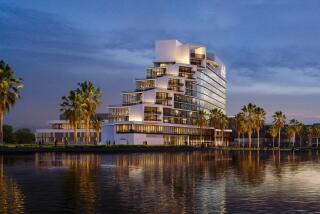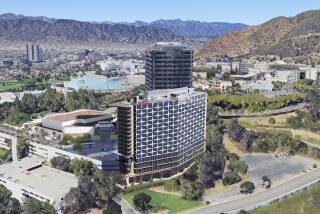Council OKs Balboa Park Hotel as Link to Downtown
- Share via
In the first of what San Diego City Council members said could be a bevy of projects linking Balboa Park with the booming downtown area, the council Tuesday unanimously approved plans for a six-story, 200-room hotel that will face the park from its site on 6th Avenue between Juniper and Ivy streets.
Council members and the developer predicted the $15-million Balboa Park Hotel, scheduled to open just before the completion of the downtown convention center in the summer of 1988, would likely be followed by many other developments that would serve to link the park area with the redevelopment and tourist-generating activities in the revitalized downtown area.
The hotel will feature retail shops, a restaurant and cocktail lounge and a rooftop swimming pool. It will be built on 1.2 acres currently occupied by a vacant, three-story office building and a commercial parking lot. The project won the approval of the council despite fears by the city Planning Department that it would set a precedent for large developments in the approach area to Lindbergh Field.
“This is a very important project for a number of reasons,” said Councilman Uvaldo Martinez, who represents the Balboa Park area. “This is one of the first steps of a future movement to link Balboa Park with downtown. That’s going to become increasingly important as the redevelopment of downtown progresses. And it’s a very positive trend to see us continue to provide access to Balboa Park and serve those who want to stay nearby.”
The Planning Department had recommended against approval of the project, because it felt the intensive use of the land was inappropriate in the area under the approach to Lindbergh Field. Last year, the hotel plans were redesigned after the Federal Aviation Administration ruled that if the structure were taller than 88 feet, it would interfere with the flight path.
“The key issue associated with the plan amendment is that of the impact of intensification of land use in the Lindbergh Field approach area,” said a report by Planning Director Jack Van Cleave. “The Planning Department feels that significant unresolved issues related to the cumulative impact of the intensification . . . remain. Until a basis can be established to make decisions that will protect the health and safety of residents and not jeopardize the future operations of Lindbergh Field, changes in land use and intensification of land uses should be avoided.”
Malcolm Hughes, president of Maxim Pacific, developer of the hotel, said, “We’re timing our opening so we’ll be in high gear when the convention center comes on line. This is a fantastic location for a first-class hotel, and that’s what we’re intending to build. We chose the location because we thought it was close enough to benefit from the downtown building boom, but still, at least for now, a little bit away from the other hotels that will be our major competitors.
“That area of town is going to be the next really important location for future growth in the city, which is why we were so anxious to build our hotel there. More and more people are going to want to stay in this part of the city so they can take advantage of Balboa Park, as well as the convention center and the downtown attractions.”
The Balboa Park Hotel marks the first San Diego development project for La Jolla’s Maxim Pacific. Hughes said the firm has done most of its work in England, concentrating on residential and commercial developments. “We got involved here because, with the piece of land available for our hotel, we feel this is a can’t-miss project,” Hughes said.
“There’s a great need for a new first-class hotel adjacent to Balboa Park,” said local attorney Herbert Solomon, who represents the developer. “This will be a positive factor adding to the strength of Balboa Park. It will provide much-needed restaurant and cocktail lounge space for patrons of the museums and the various theaters in the area. And there will be a new, more exciting pedestrian environment created by the hotel that could extend as far as the downtown area.”
Van Cleave warned that the hotel would involve “developing the land at a considerable higher intensity than the Planning Department would recommend in an airport approach zone . . . In terms of height and bulk, the proposed six-story structure, covering an entire block, would be in scale with several of the newer buildings in the neighborhood, but would be several floors higher and considerably more massive than other buildings in the immediate vicinity.”
More to Read
Sign up for Essential California
The most important California stories and recommendations in your inbox every morning.
You may occasionally receive promotional content from the Los Angeles Times.










